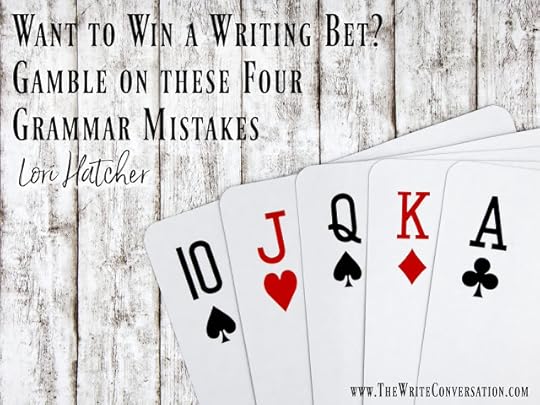Want to Win a Writing Bet? Gamble on these Four Grammar Mistakes

By Lori Hatcher @LoriHatcher2
Every good gambler knows to bet on the side of probability. Probability is simply the likelihood that something will happen.
When I sit down to edit a client’s work, it’s probable they’ll make at least one and perhaps all four of the errors I’m about to describe. If you need to make some fast cash in the writing circles, you’ll win almost every wager if you bet on the probability of finding one or more of these mistakes in your writing buddies’ work.
If you’re not a gambler but want to create writing that sings, take note of these errors and eliminate them from your work. When you do, you’ll not only create pieces that will wow an editor, but you’ll never lose a grammar bet.
4 Common Grammar Mistakes
Error #1: Falling into the “ing” trap.
“We were trying to …” or “She was skiing toward …” Whenever you see an “ing” in your copy, think twice about whether you need it. You probably don’t.
“Ing” words are called gerunds—passive verbs followed by “-ing” words. Gerunds often sneak into your writing like this:
She was hiking toward the cliff.
They were walking to the park.
Instead, get rid of “were” or “was,” then eliminate that “ing” and replace it with past tense: “She hiked toward the cliff” or “They walked to the park.”
Pruning excessive “ings” makes your writing clearer and easier to read. If you find a gerund attached to a passive verb, swap out the phrase for a single active verb. Voila! You just created a stronger sentence.
Error #2: Eliminate “started to.”
Did you start to walk the dog, or did you walk the dog? Is the car starting to roll down the hill, or is it rolling down the hill?
“Start to” can be challenging to eliminate because sometimes you need it. Usually, you don’t.
Here’s a correct usage: “I started to walk the dog, but the phone rang, and I answered it.”
“I started to cook dinner, but the electricity went out, so we ordered takeout.”
Rather than making “start” the active verb, use the verb that’s more active — like walking or rolling — to tell your story.
Error #3: Using “there is” or “there are” at the beginning of sentences
This is sometimes a symptom of lazy writing. There are lots of creative ways to start sentences.
Ha!
See how easy it is to make this mistake? Instead of starting a sentence with “there is,” try turning the phrase around to include a verb or start with you.
For example, replace the sentences above with “Lazy writing often uses these sentence openers,” or “Start your sentences in a more creative way.” If your copy includes phrases that begin with “there is” or “there are,” rewrite most of them.
Error #4: Mixing Up This and That
We use the word this to show or point out an object, person, idea, time, etc. which is physically with us, or close to us, or which is recently mentioned, experienced, or supposed to be understood. It may also refer to something symbolically or emotionally “close.”
That can refer to something “over there” or to something not as symbolically or emotionally “close” as this is.
When we talk about a particular object, idea, or person, which is previously mentioned or implied, we use the word ‘that’. We also use it to refer to someone or something far away from the speaker.
Place Your Bets
There you have it—four errors you’ll likely find in someone else’s writing. Use this knowledge to win big at the writers’ betting pools OR create stellar pieces that make editors say, “Wow!”
TWEETABLE
 Lori Hatcher loves God even more than she loves chocolate—and that’s a lot. Since He saved her at age 18, she’s been on a relentless journey to know and love Him more. Her deepest desire is for others to join her on the journey. As an author, blogger, and women’s ministry speaker, she writes for Our Daily Bread, Guideposts, Revive Our Hearts, and Crosswalk.com. She’s written three devotional books, including Refresh Your Faith, Uncommon Devotions from Every Book of the Bible, and Hungry for God…Starving for Time, Five-Minute Devotions for Busy Women. Connect with her at LoriHatcher.com or on Facebook, Twitter (@lorihatcher2) or Pinterest (Hungry for God).
Lori Hatcher loves God even more than she loves chocolate—and that’s a lot. Since He saved her at age 18, she’s been on a relentless journey to know and love Him more. Her deepest desire is for others to join her on the journey. As an author, blogger, and women’s ministry speaker, she writes for Our Daily Bread, Guideposts, Revive Our Hearts, and Crosswalk.com. She’s written three devotional books, including Refresh Your Faith, Uncommon Devotions from Every Book of the Bible, and Hungry for God…Starving for Time, Five-Minute Devotions for Busy Women. Connect with her at LoriHatcher.com or on Facebook, Twitter (@lorihatcher2) or Pinterest (Hungry for God).



